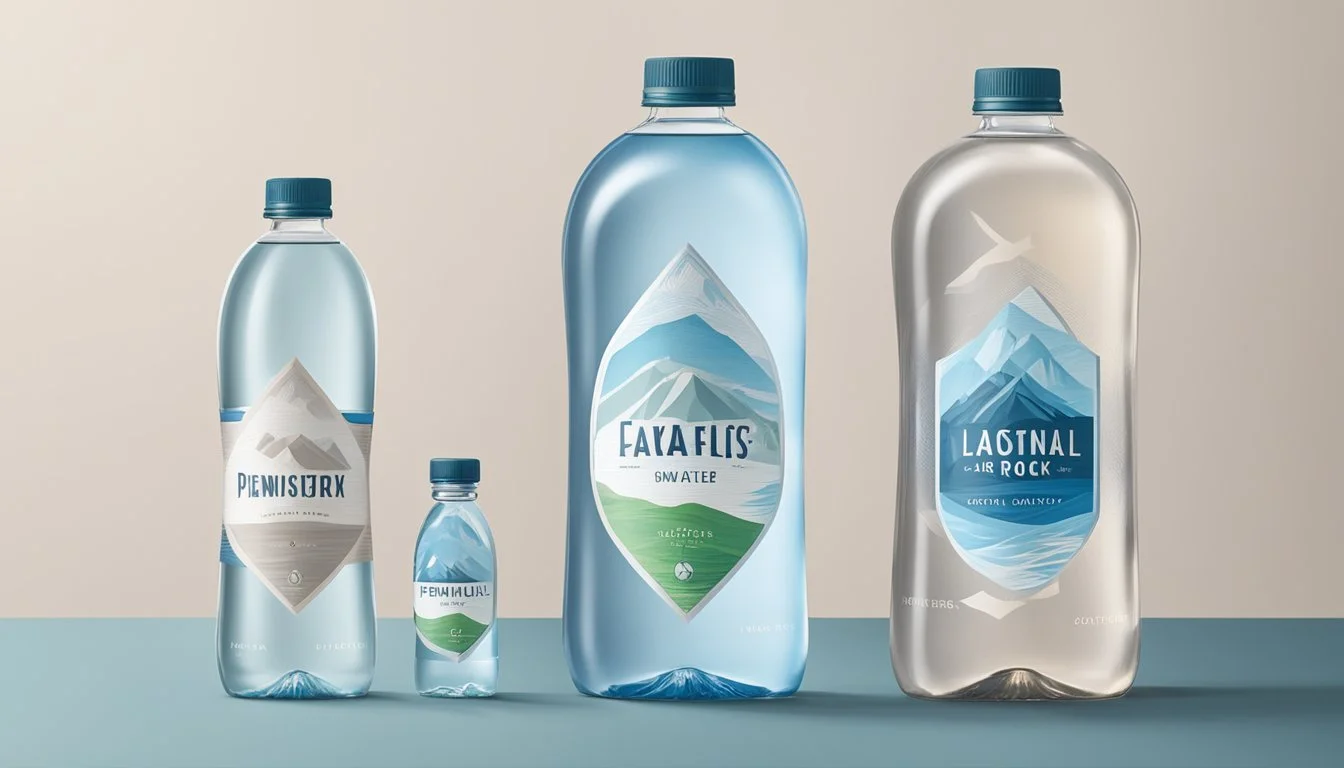Penta vs. Castle Rock
Comparing Bottled Water Quality and Taste
Choosing the best bottled water often comes down to personal preference and specific needs, but examining the details can help make an informed decision. Penta, known for its 13-step purification process, promises ultra-pure water, appealing to those seeking the cleanest hydration option. On the other hand, Castle Rock stands out for its dedication to sustainability, sourcing its water from pristine springs in Northern California.
When it comes to taste, Penta offers a crisp and clean flavor profile with no additives, catering to those who prefer their water pure and straightforward. Castle Rock boasts a naturally smooth taste derived from its natural spring source, which may appeal to consumers who value a slight mineral presence in their water.
For those prioritizing environmental impact, Castle Rock’s environmentally friendly packaging and commitment to sustainability make it a strong contender. While Penta excels in purity and taste, Castle Rock’s dedication to sustainability sets it apart in the crowded bottled water market. Both brands have distinct advantages, making the choice largely dependent on individual preferences and values.
Understanding Bottled Water
Understanding bottled water involves exploring its various sources, the stringent health and safety standards it must meet, and comparing it to tap water in terms of quality and convenience.
Sources and Types of Bottled Water
Bottled water comes from multiple sources and varies in type. Natural spring water originates from underground springs and is directly bottled at the source without significant alteration. Purified water, on the other hand, is typically sourced from municipal supplies and undergoes extensive purification processes such as distillation or reverse osmosis to remove contaminants.
Mineral water is another popular type, rich in minerals like calcium and magnesium, naturally found in the water. These characteristics often influence taste and potential health benefits. The source of bottled water heavily impacts its chemistry and overall experience.
Health and Safety Standards
Health and safety standards for bottled water are stringent and rigorously enforced to ensure consumer safety. In the United States, the Food and Drug Administration (FDA) regulates bottled water under the Federal Food, Drug, and Cosmetic Act. The FDA mandates comprehensive testing for contaminants including microbial pathogens, chemical residues, and heavy metals.
Bottling facilities must adhere to sanitary practices to avoid contamination during processing, packaging, and storage. Regular inspections and adherence to Good Manufacturing Practices (GMP) are required. These measures ensure that bottled water matches or exceeds the safety criteria of tap water, often perceived as the benchmark for drinking water safety.
Bottled vs. Tap Water
Bottled water and tap water differ in terms of source, purification processes, and consumer perception. Tap water generally comes from surface water or groundwater, treated by municipal water systems to meet the Environmental Protection Agency (EPA) standards. Tap water may contain traces of chlorine or fluoride, used to kill bacteria and promote dental health.
Bottled water may appeal due to its perceived purity, convenience, and taste preferences. Consumers often choose bottled water for its consistent quality and mineral content, absent in many tap water supplies. While tap water is more cost-effective and environmentally friendly, bottled water's quality assurance and portability make it a popular choice.
These distinctions highlight the complex interactions between source, treatment, and consumer preference in the bottled water market.
Analyzing Water Quality and Purity
Understanding the purity and quality of bottled water is essential for determining its safety and suitability for consumption. This discussion covers the significance of water purity and the key factors that impact water quality.
Importance of Water Purity
Water purity refers to the absence of contaminants that could potentially harm health. High purity means fewer harmful substances like heavy metals and microorganisms.
Penta water boasts rigorous purification processes, aiming to remove impurities to achieve near-perfect purity. This makes it appealing for those seeking exceptionally pure water. In contrast, Castle Rock sources its water from natural springs and emphasizes minimal processing, which may result in trace minerals being present.
Whenever choosing bottled water, look for certifications or purity claims, ensuring the water meets stringent safety standards and has low contaminant levels.
Factors Affecting Water Quality
Several factors can affect water quality, including the source, filtration, and packaging processes. Source water plays a vital role in determining the initial quality. Castle Rock uses natural spring water, which can contain beneficial minerals but also potential contaminants.
Filtration methods are critical in eliminating harmful substances. Penta's multi-step purification process, often involving reverse osmosis, aims to remove heavy metals, lead, and other contaminants.
Packaging can also influence quality. Materials used can leach chemicals into the water. Comparative tests often reveal differences in contaminant levels among brands. Ensuring bottled water meets EPA standards for safety and quality is crucial.
Choosing between Penta and Castle Rock involves evaluating these factors to decide which aligns best with your health priorities.
Taste Profile Comparison
Penta and Castle Rock bottled waters differ significantly in their taste profiles, influenced by factors like mineral content, pH levels, and alkalinity. Understanding these elements helps provide a clearer picture of consumer preferences for each brand.
Taste Factors in Bottled Water
Mineral content plays a critical role in determining the taste of bottled water. Penta water is known for its purity, containing very few minerals, which results in a clean, neutral taste. Castle Rock, on the other hand, contains a higher mineral content, giving it a crisp and slightly more robust flavor.
When examining pH levels, Penta tends to be more acidic, often around a pH of 6.5-7.0. This slight acidity can contribute to its sharper taste profile. In contrast, Castle Rock boasts an alkaline pH level, around 8.0-8.5, which can impart a smoother taste experience.
Alkalinity and water source significantly affect the overall taste. Castle Rock, sourced from natural springs, retains earthy and mineral notes. Penta's rigorous purification process removes many of these elements, providing a taste that some describe as nearly flavorless, appealing to those who prefer a minimalistic water profile.
Water Taste and Consumer Preferences
Consumer preferences for water taste vary greatly. Some people enjoy the neutral and subtle taste of Penta, appreciating its lack of any dominant flavors. This preference often links back to perceptions of purity and the desire for a clean, refreshing drink without additional mineral flavors.
Other consumers prefer the distinct and crisp taste of Castle Rock. The mineral content and alkalinity provide a fuller, more complex flavor which can be more satisfying for those who enjoy slightly flavored water that still feels natural and refreshing.
Personal preference also influences choice due to health considerations. Individuals seeking water with higher alkalinity to counteract acidity in the body may lean toward Castle Rock. In contrast, those who prioritize ultra-pure water with minimal content may choose Penta, reflecting a preference for simplicity and clean taste profiles.
Brands at a Glance
In the world of bottled water, there are recognizable major players and intriguing niche brands. This section highlights key details about both, providing a snapshot of their positions in the market and what sets them apart for consumers.
Major Players in the Bottled Water Market
Large companies dominate the market with well-known brands, ensuring safe drinking water is widely available. Coca-Cola produces Dasani and Smartwater, which are popular choices in many households.
PepsiCo offers Aquafina, a brand trusted for its consistency and wide distribution.
Nestlé Waters owns Pure Life and San Pellegrino, catering to both still and sparkling water preferences.
Brands like Evian and Fiji stand out for their natural sources, appealing to consumers looking for premium options. Essentia and Voss are also notable, providing high-quality, electrolyte-enhanced waters.
Niche Brands: Penta and Castle Rock
Penta and Castle Rock focus on unique selling points to carve out their niches in the crowded bottled water market.
Penta stands out with its ultra-purification process, which claims to remove impurities down to one part per million. This appeals to health-conscious consumers seeking the purest water possible.
Castle Rock offers spring water sourced from pristine locations with a natural, crisp flavor. It appeals to those who appreciate water's natural character without added minerals.
Both brands cater to eco-conscious consumers through sustainable practices. This includes using recyclable packaging, which differentiates them in a market focused on both quality and environmental impact.
Health Benefits and Concerns
Both Penta and Castle Rock bottled waters offer distinct health benefits and potential concerns based on their compositions and production processes. Understanding these differences can help consumers make informed choices.
Electrolytes and Mineral Balance
Penta water undergoes a rigorous reverse osmosis process that removes impurities, but this also means it has fewer natural minerals. While it is pure and safe, the lack of electrolytes may be a concern for those relying on bottled water for these essential nutrients. Electrolytes like sodium, potassium, and magnesium are vital for muscle function, nerve signaling, and maintaining fluid balance.
Castle Rock water, sourced from natural springs, retains its natural mineral content. This includes beneficial electrolytes, which can contribute positively to the body’s hydration status and overall health. Being naturally mineral-rich, Castle Rock water might be more suitable for individuals looking to maintain electrolyte balance along with hydration.
Hydration and Its Impact on Health
Hydration is fundamental to overall health, affecting everything from skin health to cognitive function. Penta water, being ultra-purified, is excellent for individuals with sensitivities to certain contaminants found in ordinary water. This can include those with compromised immune systems who require the purest water available.
Castle Rock, with its natural mineral content, not only hydrates but also provides additional health benefits from its natural spring source. The presence of minerals like calcium and magnesium can support bone health and metabolic functions. For those who prioritize both hydration and a natural source of minerals, Castle Rock may hold an edge.
In summary, while both Penta and Castle Rock offer merits, the choice ultimately depends on individual health needs, particularly concerning electrolyte intake and hydration preferences.
Environmental and Sustainability Considerations
When evaluating the environmental and sustainability aspects of Penta and Castle Rock bottled waters, key areas of interest include the packaging materials used, recycling initiatives, and the sourcing and manufacturing processes employed by each brand.
Packaging and Recycling
Penta utilizes lightweight, BPA-free plastic for their bottles which helps in reducing the overall plastic usage. This plastic is 100% recyclable, aligning with eco-friendly practices. Penta also ensures their packaging process meets various environmental regulations.
Castle Rock bottles are made from 100% recycled plastic (rPET), making their packaging particularly environmentally friendly. They actively promote recycling programs and partner with local communities to reduce plastic waste. This commitment significantly lowers the environmental impact.
Comparison Table:
Brand Bottle Material Recyclability Additional Initiatives Penta BPA-free plastic 100% Adheres to environmental regulations Castle Rock 100% recycled plastic (rPET) 100% Community recycling partnerships
Sourcing and Manufacturing Process
Penta sources its water through a multi-step purification process that eliminates contaminants without harming the natural environment. This method focuses on sustainability by minimizing water waste and energy consumption during manufacturing.
Castle Rock, on the other hand, sources water from natural springs in a sustainable manner, ensuring the preservation of local ecosystems. Their manufacturing process includes renewable energy usage, further enhancing their eco-friendly approach. They also limit transport emissions by opting for local sourcing whenever possible.
Penta's sustainable sourcing and usage of purified water ensure minimal ecological disruption.
Castle Rock’s spring water sourcing and renewable energy initiatives underscore their commitment to environmental sustainability.
Consumer Choices and Trends
Increasing awareness around health and sustainability is influencing consumer preferences in the bottled water market. Shifting lifestyles and the social impact of brand choices are pivotal for today's consumers.
Trend Toward Healthier Options
Consumers are increasingly prioritizing bottled water that offers health benefits. Brands like Penta and Castle Rock cater to this demand by providing options that are free of contaminants and rich in essential minerals.
Penta Water: Known for its ultra-purification process, Penta promises a cleaner, more hydrating experience. This appeals to health-conscious individuals looking to avoid impurities.
Castle Rock Water: Sourced from a pristine environment, Castle Rock markets its water as naturally alkaline, which is attractive to those who believe in the health benefits of alkaline pH.
These health trends align with broader market movements towards clean and functional beverages.
Social Responsibility in Brand Choice
Modern consumers are also attentive to the social and environmental actions of bottled water brands. They tend to support companies that demonstrate social responsibility.
Penta Water: This brand emphasizes its eco-friendly practices, including sustainable sourcing and reduced plastic use. This resonates with consumers who value environmental stewardship.
Castle Rock Water: Taking it a step further, Castle Rock leverages its local sourcing and contributions to community projects. This enhances brand loyalty among socially-conscious buyers.
Brand loyalty is increasingly being driven by the values and ethics of companies, not just the products they offer.
Final Remarks on Penta and Castle Rock
When comparing Penta and Castle Rock bottled waters, several aspects stand out. Penta offers unparalleled purity, emphasizing its 11-hour, 13-step purification process that excludes potentially harmful contaminants. On the other hand, Castle Rock prides itself on its natural spring water sourced from the pristine springs of Mount Shasta, offering an eco-friendly choice with a low carbon footprint.
Taste and Quality
Both brands have distinct advantages in taste and quality. Penta is known for its clean, crisp flavor, attributed to its extensive purification. Castle Rock provides a refreshing natural taste, preserving the minerals and natural qualities of the spring water.
Packaging and Sustainability
In terms of packaging, Penta uses BPA-free plastic bottles, ensuring safety without compromising the environment. Castle Rock takes a step further with its glass bottles and commitment to sustainable practices.
Aspect Penta Castle Rock Purity 13-step purification process Natural spring water Taste Clean and crisp Refreshing and natural Packaging BPA-free plastic Glass bottles Sustainability Standard environmental controls Eco-friendly sourcing and low carbon impact
Final Assessment
Choosing between Penta and Castle Rock depends on individual preferences regarding purity, taste, and environmental impact. Penta excels in providing water with high purity levels, while Castle Rock offers a more natural taste and eco-conscious packaging. Both brands stand out in their respective strengths, making either a reliable choice for consumers.
More About Penta
Mountain Valley Spring Water vs Penta: Which Bottled Water is Better?
Penta vs Richard's Rainwater: Which Bottled Water is Better?
Penta vs Whole Foods Italian Still Mineral water: Which Bottled Water is Better?
More About Castle Rock
Aqua Carpatica vs Castle Rock: Which Bottled Water is Better?
Castle Rock vs Cascade Mountain: Which Bottled Water is Better?
Castle Rock vs Crystal Geyser: Which Bottled Water is Better?
Castle Rock vs Hawaii Volcanic: Which Bottled Water is Better?
Castle Rock vs Hawaiian Springs: Which Bottled Water is Better?
Castle Rock vs Kirkland Signature: Which Bottled Water is Better?
Castle Rock vs Purely Sedona: Which Bottled Water is Better?
Castle Rock vs Richard's Rainwater: Which Bottled Water is Better?
Castle Rock vs Solan de Cabras: Which Bottled Water is Better?
Castle Rock vs Talking Rain AQA: Which Bottled Water is Better?
Castle Rock vs Whole Foods 365: Which Bottled Water is Better?
Castle Rock vs Whole Foods Italian Still Mineral water: Which Bottled Water is Better?
Core Hydration vs Castle Rock: Which Bottled Water is Better?
Icelandic Glacial vs Castle Rock: Which Bottled Water is Better?
Mountain Valley Spring Water vs Castle Rock: Which Bottled Water is Better?
Nestle Pure Life vs Castle Rock: Which Bottled Water is Better?
Poland Spring vs Castle Rock: Which Bottled Water is Better?
San Pellegrino vs Castle Rock: Which Bottled Water is Better?







